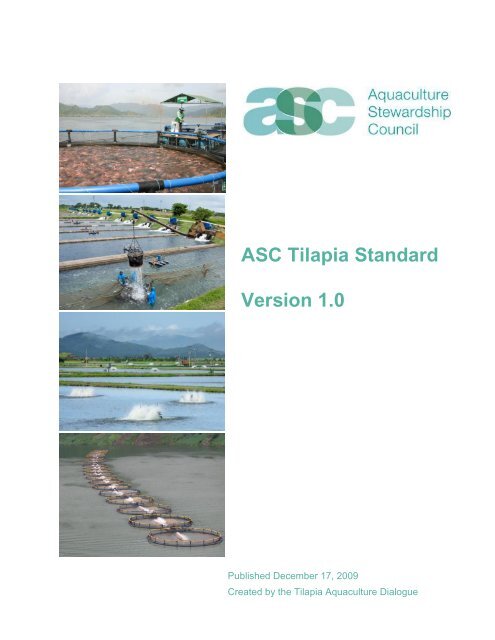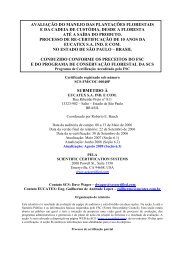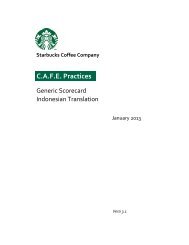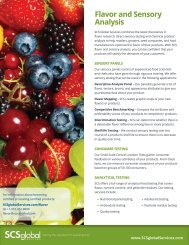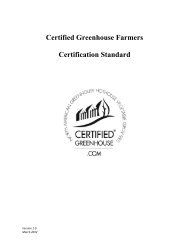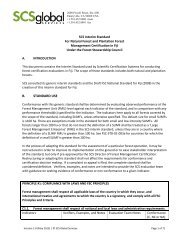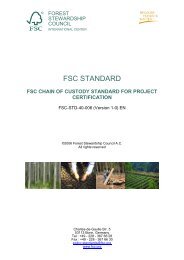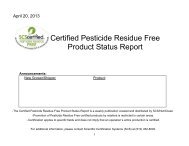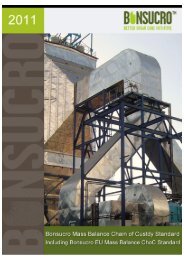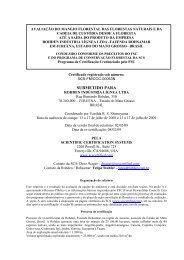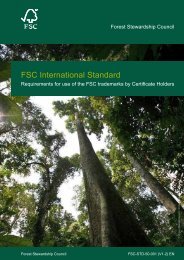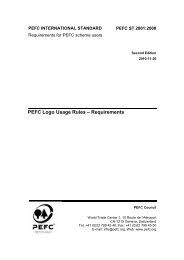ASC Tilapia Standard Version 1.0 - SCS Global Services
ASC Tilapia Standard Version 1.0 - SCS Global Services
ASC Tilapia Standard Version 1.0 - SCS Global Services
Create successful ePaper yourself
Turn your PDF publications into a flip-book with our unique Google optimized e-Paper software.
<strong>ASC</strong> <strong>Tilapia</strong> <strong>Standard</strong><strong>Version</strong> <strong>1.0</strong>Published December 17, 2009Created by the <strong>Tilapia</strong> Aquaculture Dialogue
Copyright © 2011 <strong>ASC</strong>. All rights reserved by Aquaculture Stewardship Council.First published December 17, 2009This edition/version October 3, 2011(Introduction updated, <strong>ASC</strong>-style applied, document renamed from ISRTA to <strong>ASC</strong> <strong>Tilapia</strong> <strong>Standard</strong>, content of the standards unchanged)(original title: International <strong>Standard</strong>s for Responsible <strong>Tilapia</strong> Aquaculture)<strong>ASC</strong> <strong>Tilapia</strong> <strong>Standard</strong> version <strong>1.0</strong>
TABLE OF CONTENTSINTRODUCTION .................................................................................................................... 5UNDERSTANDING STANDARDS, ACCREDITATIONAND CERTIFICATION .................................................................................................... 6PURPOSE AND SCOPE OF THE <strong>ASC</strong> TILAPIA STANDARD ............................................. 6Purpose of the <strong>Standard</strong>s ........................................................................... 6Scope of the <strong>Standard</strong>s ............................................................................... 6Issue areas of tilapia aquaculture to which the standards apply ............. 6Supply or value-added chain of tilapia aquaculture to which thestandards apply ................................................................................ 6Range of activities within aquaculture to which the standards apply ...... 7Geographic scope to which the standards apply .................................... 7Unit of certification to which the standards apply .................................... 7PROCESS FOR SETTING THE STANDARDS ..................................................................... 8General Considerations .............................................................................. 8Process for Setting the <strong>ASC</strong> <strong>Tilapia</strong> <strong>Standard</strong> .......................................... 8Continuous Improvement of the <strong>ASC</strong> <strong>Tilapia</strong> <strong>Standard</strong> ........................... 91. PRINCIPLE: OBEY THE LAW AND COMPLY WITH ALL NATIONAL AND LOCALREGULATIONS ............................................................................................................. 101.1. Criteria: Evidence of legal compliance ............................................ 102. PRINCIPLE: MANAGE THE FARM SITE TO CONSERVE NATURAL HABITAT ANDLOCAL BIODIVERSITY ................................................................................................ 112.1. Criteria: Site information ................................................................... 112.2. Criteria: Presence of natural or established tilapia species .......... 122.3. Criteria: The effects of eutrophication ............................................. 132.4. Criteria: Water quality in oligotrophic receiving waters ................. 132.5. Criteria: Receiving water monitoring ............................................... 142.6. Criteria: Wetland conservation ......................................................... 153. PRINCIPLE: CONSERVE WATER RESOURCES ........................................................ 163.1. Criteria: Nutrient utilization efficiency ............................................. 163.2. Criteria: Groundwater salinization ................................................... 17
<strong>ASC</strong> <strong>Tilapia</strong> <strong>Standard</strong> version <strong>1.0</strong> 44. PRINCIPLE: CONSERVE SPECIES DIVERSITY AND WILD POPULATIONS ........... 184.1. Criteria: Escapes from aquaculture facilities .................................. 184.2. Criteria: Transporting live tilapia ...................................................... 194.3. Criteria: Transgenic fish .................................................................... 194.4. Criteria: Predator control .................................................................. 195. PRINCIPLE: USE RESOURCES RESPONSIBLY ........................................................ 215.1. Criteria: Use of wild fish for feed (fishmeal and oil) ...................... 215.2. Criteria: Preference for better feed manufacturers ........................ 225.3. Criteria: Energy use ........................................................................... 236. PRINCIPLE: MANAGE FISH HEALTH AND WELFARE IN AN ENVIRONMENTALLYRESPONSIBLE MANNER ............................................................................................ 246.1. Criteria: Stocked tilapia recovery ..................................................... 246.2. Criteria: Chemicals ............................................................................ 256.3. Criteria: Mortalities ............................................................................ 256.4. Criteria: Fish health management .................................................... 267. PRINCIPLE: BE SOCIALLY RESPONSIBLE ............................................................... 277.1. Criteria: Child labor ........................................................................... 277.2. Criteria: Forced, bonded, compulsory labor ................................... 287.3. Criteria: Discrimination in the work environment ........................... 287.4. Criteria: Health and safety of workers ............................................. 297.5. Criteria: Wages, overtime and working hours ................................. 297.6. Criteria: Freedom of association and right to collective bargaining307.7. Criteria: Disciplinary Actions ............................................................ 317.8. Criteria: Action response plans/policies ......................................... 317.9. Criteria: Living conditions for employees(if workers are housed on site) ........................................................ 327.10. Criteria: Community relations and interaction ............................... 32APPENDIX I: SITE AND RECEIVING WATER CHECKLIST .............................................. 33APPENDIX II: RECEIVING WATER MONITORING ............................................................ 35APPENDIX III: WATER RESOURCE CALCULATIONS ..................................................... 37APPENDIX IV: FEED RESOURCE CALCULATIONS ........................................................ 39APPENDIX V: EXPLANATION OF FISHSOURCE SCORING ............................................ 40
INTRODUCTIONSeafood is one of the most important sources of protein worldwide. Half of the seafood we eat comesfrom aquaculture; it is the fastest-growing food production system in the world. However, as theindustry expands, so does its footprint on the environment and on society. It is imperative that we facethe challenge of minimising these potentially negative impacts. The goal of Aquaculture StewardshipCouncil (<strong>ASC</strong>) is to transform aquaculture towards an environmental and social responsible foodsource.One of the cornerstones of this transformation is creating robust and credible standards forresponsible aquaculture production. <strong>Standard</strong>s help reassure seafood buyers that aquacultureproducts do not harm the environmental or have socially adverse impacts. One way buyers cansupport sustainability is by purchasing certified products that have been produced in compliance withthe <strong>ASC</strong> standards.Through the <strong>Tilapia</strong> Aquaculture Dialogue (TAD), performance-based, metric standards have beendeveloped. The standards, combined in the ―<strong>ASC</strong> <strong>Tilapia</strong> <strong>Standard</strong>‖, are the numbers and/orperformance levels that must be reached to determine if an impact is being addressed. 1Each standard is based on an impact, principle, criteria and indicator, as defined below:Impact: The problem to be addressed. The TAD identified seven environmental and socialimpacts.Principle: The high-level goal for addressing the impact.Criteria: The area to focus on to address the impact.Indicator: What to measure in order to determine the extent of the impact.Created in 2005, the TAD included more than 200 tilapia producers, environmental and social nongovernmentalorganizations (NGOs), development organizations, retailers, wholesalers, aquacultureassociations, feed manufacturers, academics, researchers, government representatives andindependent consultants. The TAD Steering Committee, which served as the decision-making body forthe TAD, included representatives from three tilapia producing companies (Aquamar, Rain ForestAquaculture and Regal Springs Trading Company) that operate re-circulating, cage, pond and/or flowthroughproduction systems. The committee also included representatives from three NGOs: NewEngland Aquarium, Sustainable Fisheries Partnership and World Wildlife Fund-US. For moreinformation about the roles and responsibilities of the TAD, see the TAD Process Document.The full suite of standards (including principles, criteria and indicators) are described in this document.The document also details the targets the TAD accepted. The Auditor Guidance Manual documentexplains the methodologies used to determine if the <strong>ASC</strong> <strong>Tilapia</strong> <strong>Standard</strong> is being met. A BetterManagement Practices (BMP) manual for tilapia aquaculture has also been created. The manual,geared toward producers, will explain specific steps that can be taken to achieve compliance with the<strong>ASC</strong> <strong>Tilapia</strong> <strong>Standard</strong>. The BMP manual will be particularly useful to those producers who do not havethe capability to test new and innovative techniques that could be used to meet or exceed the <strong>ASC</strong><strong>Tilapia</strong> <strong>Standard</strong>.1 A numerical result is not necessary when an indicator cannot be quantified (e.g., the indicator for the principle―Obey the law,‖ is ―Documentation of compliance with national and local regulations.‖ Thus, evidence of thenecessary documentation satisfies the requirement.<strong>ASC</strong> <strong>Tilapia</strong> <strong>Standard</strong> version <strong>1.0</strong> 5
UNDERSTANDING STANDARDS, ACCREDITATION ANDCERTIFICATIONCertification is the validation that standards have been achieved by producers. Certification may alsorefer to the labeling of companies, practices, operations or products that conform to the standards.Certification schemes encompass the processes, systems, procedures and activities related to threeprimary functions: standard-setting, accreditation and certification (i.e., verification of compliance, alsoknown as ―conformity assessment‖). Aquaculture certification schemes must be consistent withrigorous procedures for standard-setting, accreditation and certification to ensure that certificationschemes are credible. With this in mind, the TAD sought to follow the International Social andEnvironmental Accreditation and Labelling (ISEAL) Alliance’s ―Code of Good Practice for SettingSocial and Environmental <strong>Standard</strong>s‖ when creating the standards.For standard-setting (i.e., the process of creating the acceptable tolerance levels or limits of impacts),it is essential that the process is not dominated by one, or a few, stakeholder groups. The standardswill be more credible and effective if they are based on the expertise and experiences of a broad anddiverse group of people who are interested in aquaculture (e.g., producers who use differentmanagement practices, conservationists from international and local organizations, and scientists whospecialize in different fields related to aquaculture).For accreditation (i.e., the process of authorizing entities to verify compliance with the standards), it isimportant that there is no conflict of interest between the entities that participated in the standardsettingprocess, the entity that manages the standards, the entity that accredits third party certificationbodies, and the entity that undertakes the third party certification. Firewalls are required betweenthese various entities to assure that independence and credibility are maintained.For certification (i.e., the process of verifying compliance with the standards), it is critical that there isno conflict of interest between the entity that conducts this function, the entities that participated in thestandard-setting process, the entity that manages the standards, and the entity that accredits thecertifiers. The organization that generates revenue from the labeling of products and distribution ofcertificates must not have any connections with the standard-setting body, as this could create anincentive to increase revenues by weakening standards. For the same reasons, the auditorsdetermining compliance of a farm should not have a conflict of interest with the standardsdevelopment body. The auditors also should not be housed in the certification body, given that therevenue generated from the certificates could influence the nature by which the audit is conducted.For this reason, third party certification is the most robust and credible process.PURPOSE AND SCOPE OF THE <strong>ASC</strong> TILAPIA STANDARDPurpose of the <strong>Standard</strong>sThe purpose of the <strong>ASC</strong> <strong>Tilapia</strong> <strong>Standard</strong> is to provide a means to measurably improve theenvironmental and social performance of tilapia aquaculture operations.Scope of the <strong>Standard</strong>sIssue areas of tilapia aquaculture to which the standards applyThe <strong>ASC</strong> <strong>Tilapia</strong> <strong>Standard</strong> establishes principles, criteria, indicators and measurable performancelevels for responsible tilapia aquaculture with regard to social and environmental issues.Supply or value-added chain of tilapia aquaculture to which the standards apply<strong>ASC</strong> <strong>Tilapia</strong> <strong>Standard</strong> version <strong>1.0</strong> 6
The <strong>ASC</strong> <strong>Tilapia</strong> <strong>Standard</strong> addresses the most significant environmental and social impacts of tilapiaaquaculture, which primarily originate from the production systems and the immediate inputs toproduction, such as feed, seed, chemicals and water. Additionally, social impacts related to on-farmlabor and community relations are addressed.Range of activities within aquaculture to which the standards applyAquaculture is the production of aquatic organisms. It involves the planning, development andoperation of facilities, which in turn affect the inputs, production, processing and chain of custodycomponents.The <strong>ASC</strong> <strong>Tilapia</strong> <strong>Standard</strong> applies to the planning, development and operation of tilapia aquacultureproduction systems. Planning includes farm siting; resource use or extraction; and assessment ofenvironmental, social and cumulative impacts. Development includes construction, habitat alterationand access to public areas by other resource users. Operation includes effluent discharge, workingconditions, use of antibiotics and other chemicals, as well as feed composition and use.Geographic scope to which the standards applyThe <strong>ASC</strong> <strong>Tilapia</strong> <strong>Standard</strong> applies to all locations and scales of tilapia farm-based aquacultureproduction systems in the world. The <strong>ASC</strong> <strong>Tilapia</strong> <strong>Standard</strong> is intended for internationally tradedtilapia.Although there has been an increased level of consumption of tilapia in wealthier countries duringrecent years, it is expected that tilapia production in less-developed countries will continue to bepromoted in an effort to bolster food security in those regions. The <strong>ASC</strong> <strong>Tilapia</strong> <strong>Standard</strong> does notseek to impede or restrict the general development of tilapia operations, but rather to address theproduction of tilapia that is traded internationally. Every action that has an impact on natural resourcescould be perceived as limiting the resilience of the resources. Conversely, every action that humanbeings take could be perceived as necessary for survival. The <strong>ASC</strong> <strong>Tilapia</strong> <strong>Standard</strong> attempts toreduce the ambiguity between these extremes and clarify what is an acceptable level of impact.Unit of certification to which the standards applyThe unit of certification is the system within the production chain sought to be examined. In the case ofthe <strong>ASC</strong> <strong>Tilapia</strong> <strong>Standard</strong>, the unit of production is the farming operation. The size of the productionoperation can vary considerably. Given that the focus of the <strong>ASC</strong> <strong>Tilapia</strong> <strong>Standard</strong> is on productionand the immediate inputs to production, the unit of certification will typically consist of a single farm orsome other type of collective grouping. Specific data collection protocols will be described in the <strong>ASC</strong><strong>Tilapia</strong> guidance document.The unit of certification could be a group or cluster of facilities or operations that should, for a numberof reasons, be considered collectively as the aquaculture operation under consideration. For example,they may share resources or infrastructure (e.g., water sources or an effluent discharge system),share a landscape unit (e.g., a watershed), have the same production system, and/or involve thesame species and have a common market outlet. This group or cluster must be a legal entity thatshares a common management structure so that the <strong>ASC</strong> <strong>Tilapia</strong> <strong>Standard</strong> is binding for eachindividual producer. Regardless of the specific situation, farms and other users often can havecumulative effects on the environment and society. As a result, some of the <strong>ASC</strong> <strong>Tilapia</strong> <strong>Standard</strong> isindependent of what a producer can achieve at the farm level and rely on the efforts of the producer toact as an advocate and steward of their environment.Under the compliance assessment of the <strong>ASC</strong> <strong>Tilapia</strong> <strong>Standard</strong>, part of the unit of certificationdetermination will include the geographic and/or receiving water body delineations in which the farmcultures in or discharges. In this context, a company that owns multiple grow-out sites will be subjectto compliance at the particular site they chose to undergo certification. Certifications will not betransferable to other farms or production systems that do not undergo auditing.<strong>ASC</strong> <strong>Tilapia</strong> <strong>Standard</strong> version <strong>1.0</strong> 7
Each farm will be evaluated based on its activity. For example, if the farm operates a hatchery, thefarm and hatchery will need to comply with the standard related to the amount of phosphorus used toproduce a metric ton of tilapia. If the farm does not operate a hatchery, the farm will not be heldaccountable for the phosphorus loads that are produced at the hatchery where they source their seed.PROCESS FOR SETTING THE STANDARDSGeneral ConsiderationsThe process of setting standards is critical, as it largely determines the standards’ credibility, viability,practicality and acceptance. In accordance with ISEAL, the process of creating the <strong>ASC</strong> <strong>Tilapia</strong><strong>Standard</strong> was multi-stakeholder, open to anybody to participate and transparent.Process for Setting the <strong>ASC</strong> <strong>Tilapia</strong> <strong>Standard</strong>The <strong>ASC</strong> <strong>Tilapia</strong> <strong>Standard</strong> was developed through four years of transparent, multi-stakeholdermeetings with participants of the TAD. The TAD included many of the world's top tilapia producers andbuyers, researchers, and representatives from governments, NGOs, development groups and alliedbusinesses. The process, which was coordinated by WWF, included the following steps:WWF notified ISEAL of the intent to apply the ―Code of Good Practice for Setting Social andEnvironmental <strong>Standard</strong>s‖ to the TAD. ISEAL accepted WWF as an associate member onbehalf of all of the Aquaculture Dialogues.WWF asked key players—including producers, wholesalers, distributors, processors, feedcompanies, retailers, NGOs, government representatives and scientists—to participate in theTAD.TAD participants agreed on the seven key environmental and social impacts associated withtilapia aquaculture.TAD participants agreed on the goals and objectives for the TAD.TAD participants agreed on policies that ensured the TAD meetings encouraged candiddiscussion (e.g., policies fostering participation rather than endorsement).A Steering Committee (SC) was formed. The SC had three NGO and three aquacultureindustry representatives. The SC was responsible for managing the TAD process. Thisinvolved creating and implementing a TAD process document that, among other things,included steps for decision-making.SC members agreed on a budget for such expenses as meeting room rental, research and theTAD coordinator’s time. The SC members also agreed on the roles of different types of TADstakeholders.TAD participants agreed on draft principles, criteria, indicators and standards. The processinvolved reviewing relevant scientific research related to tilapia aquaculture.WWF wrote and disseminated press releases, and developed/updated a TAD website, to keeppeople informed of upcoming meetings and progress within the TAD.Draft principles, criteria, indicators and standards were posted for two 60-day public commentperiods. Feedback received during both comment periods was used by the SC to revise andfinalize the standards document.The SC posted responses to comments received during the public comment periods, withexplanations of why standards were or were not altered based on each comment.<strong>ASC</strong> <strong>Tilapia</strong> <strong>Standard</strong> version <strong>1.0</strong> 8
In May 2011 the standards was officially handed over to the Aquaculture Stewardship Council.In October 2011 the standard was renamed to <strong>ASC</strong> <strong>Tilapia</strong> <strong>Standard</strong>.Continuous Improvement of the <strong>ASC</strong> <strong>Tilapia</strong> <strong>Standard</strong>As stated in the ISEAL ―Code of Good Practices for Setting Social and Environmental <strong>Standard</strong>s,‖― . . . standards shall be reviewed on a periodic basis for continued relevance and effectiveness inmeeting their stated objectives and, if necessary, revised in a timely manner.” It is implicit in thedevelopment of the <strong>ASC</strong> <strong>Tilapia</strong> <strong>Standard</strong> that the numerical values, or ―tolerance levels,‖ will beraised or lowered over time to reflect new data, improved practices and new technology. Thesechanges will correspond to a lessening of impacts rather than an increase in impacts. Changes toother components of the <strong>ASC</strong> <strong>Tilapia</strong> <strong>Standard</strong> are also recognized as a way to reward betterperformance and, as science and technology allow for more precise and effective measures, the TADshall remain open to adopt these new findings within the scope of the <strong>ASC</strong> <strong>Tilapia</strong> <strong>Standard</strong>.<strong>ASC</strong> <strong>Tilapia</strong> <strong>Standard</strong> version <strong>1.0</strong> 9
1. PRINCIPLE: OBEY THE LAW AND COMPLY WITH ALLNATIONAL AND LOCAL REGULATIONSImpact: Farm operations that, intentionally or unintentionally, break the law violate a fundamentalbenchmark of performance for certified farms.1.1 Criteria: Evidence of legal complianceINDICATORSTANDARD1.1.1 Presence of documents proving compliance withlocal and national authorities on land and water use(e.g., permits, evidence of lease, concessions andrights to land and/or water use)1.1.2 Presence of documents proving compliance with alltax laws1.1.3 Presence of documents proving compliance with alllabor laws and regulations1.1.4 Presence of documents proving compliance withregulations or permits concerning water qualityimpactsYesYesYesYesRationale – Principle 1 reinforces the need for the tilapia aquaculture industry to follow the nationaland local laws of the region where tilapia aquaculture is taking place. A goal of the ISTRA is to gobeyond the law and produce more rigorous standards than those which the law requires, as long asthe legal structure of the producing country is respected.The sovereignty of individual nations to create, develop and enforce laws must be respected in the<strong>ASC</strong> <strong>Tilapia</strong> <strong>Standard</strong>. The TAD developed four key standards, based on broad legal issues, toreinforce the environmental and social significance of the <strong>ASC</strong> <strong>Tilapia</strong> <strong>Standard</strong>.<strong>ASC</strong> <strong>Tilapia</strong> <strong>Standard</strong> version <strong>1.0</strong> 10
2. PRINCIPLE: MANAGE THE FARM SITE TO CONSERVENATURAL HABITAT AND LOCAL BIODIVERSITYImpact: <strong>Tilapia</strong> farms that are improperly sited can disrupt the structure of native fish population,enhance eutrophication in the receiving waters, and cause the loss of sensitive habitat.2.1 Criteria: Site informationINDICATORSTANDARD2.1.1 Site location, history and stewardship activitiesmatrix located in Appendix 1, Table 1 is completedand validatedYesRationale – The information required in Appendix I, Table 1 provides the historical context of aparticular site where the tilapia aquaculture activity is being conducted. There is a functional need forthe specific location and surrounding site description so the physical conditions of the farm in relationto the greater environmental context can be taken into consideration during the assessment process.The collective unit of certification (whether a single farm or a group of farms) that is being audited forcompliance to the <strong>ASC</strong> <strong>Tilapia</strong> <strong>Standard</strong> must be able to demonstrate the forethought used todetermine the potential effects of the farming operation on the surrounding environment. These effectsare best acknowledged via a thorough environmental impact assessment. Because the environmentalimpacts of a farm are not static over a given timeframe, any expansion of the farm seeking to becertified will also require the potential impacts of the proposed, broader activity to be assessed.The purpose of the <strong>ASC</strong> <strong>Tilapia</strong> <strong>Standard</strong> is to identify and acknowledge producers that go above andbeyond the baseline legal frameworks in their respective countries and regions of production. Thisstewardship of the surrounding environment is sometimes difficult to quantify or embody in a standard,but should be known and acknowledged. The requirement to provide the activities that the farmundertakes to promote the broader responsible use of the natural resources that are depended on bymany is another indication of a responsible producer.<strong>ASC</strong> <strong>Tilapia</strong> <strong>Standard</strong> version <strong>1.0</strong> 11
2.3 Criteria: The effects of eutrophicationINDICATORSTANDARD2.3.1 The percent change in diurnal dissolved oxygen ofreceiving waters relative to dissolved oxygen atsaturation for the water’s specific salinity andtemperature≤ 65%Rationale – The TAD chose the diurnal dissolved oxygen fluctuation as a practical parameter forlimiting the effects of eutrophication on a particular water body.Oxygen levels in water fluctuate over a 24-hour cycle in relation to the level of photosynthesis andrespiration. As nutrients are added to a water body, primary productivity increases. This increasecauses more oxygen to be released into the water body as a byproduct of photosynthesis duringdaylight hours. Concurrently, during the day, oxygen is consumed by primary producers and otheraquatic life forms as they respire. In the absence of light, however, photosynthesis ceases butrespiration continues. Thus, during the night, oxygen is consumed, resulting in a decrease in dissolvedoxygen. The larger the primary producer population, the more oxygen is consumed. The level oreffects of eutrophication can thereby be expressed in the difference between peak daytime oxygenlevels and the reduced oxygen levels during the night. Minimizing excessive fluctuations betweendaytime and nighttime dissolved oxygen levels is of critical importance to aquaculture operations tomaintain fish health and productivity.2.4 Criteria: Water quality in oligotrophic receiving watersINDICATORSTANDARD2.4.1 Secchi disk visibility 5 limit above which production isnot certifiable10 meters2.4.2 Compliance with standards 2.4.3. & 2.4.4. whenSecchi disk visibility 5 ≤ 5.0 meters2.4.3 Total phosphorus concentration limit in receivingwaters 5Yes≤ 20 µg/L2.4.4 Chlorophyll a concentration limit in receiving waters 5 ≤ 4.0 µg/LRationale – The TAD considered it necessary to go beyond oxygen parameters (see Criteria 2.3) toprotect waters that have low nutrient concentrations and where the diurnal dissolved oxygenfluctuations are minimal; i.e., oligotrophic systems. To avoid the excessive loading of nutrient-poorsystems, a limit on the total phosphorus concentration in these receiving waters has been imposed.5 Measurements shall be taken at the Receiving Water Farm Afar (RWFA) sampling station. See Appendix II forRWFA definition.<strong>ASC</strong> <strong>Tilapia</strong> <strong>Standard</strong> version <strong>1.0</strong> 13
Additionally, a limit on the concentration of chlorophyll a has been established in an attempt to restrainthe primary productivity in these water bodies.Secchi disk visibility measures the amount of turbidity in a water column. When this method is used onsystems that are not turbid via suspended sediment (note: the distinction will be made during auditsbetween turbidity from plankton versus turbidity from suspended sediments), a strong correlationexists between low primary productivity and high Secchi disk visibility. Thus, Secchi disk visibility is auseful tool to understand key characteristics of water bodies. In the context of the <strong>ASC</strong> <strong>Tilapia</strong><strong>Standard</strong>, oligotrophic receiving waters are characterized as those that have a Secchi disk visibilityequal to or greater than 5.0 meters.Producers utilizing oligotrophic water bodies as receiving waters for tilapia operations shall be requiredto maintain Secchi disk visibility within a prescribed range to reduce effects of nutrient loading. Waterbodies with an average annual Secchi disk visibility at or above 10 meters are not permitted to beused as receiving waters under the <strong>ASC</strong> <strong>Tilapia</strong> <strong>Standard</strong> because of their ecological uniqueness andrarity. Producers utilizing receiving waters with Secchi disk visibilities ranging between 5.0 and 10.0meters will be kept to the strict limits of chlorophyll a and total phosphorus cited above if the averageannual Secchi disk visibility of the receiving waters (recorded at reference point RWFA in Table 2,Appendix II) declines to and falls below 5.0 meters.2.5 Criteria: Receiving water monitoringINDICATOR2.5.1 Receiving water quality monitoring matrix completedand validated (Appendix II)STANDARDYes (6 months data, pre-audit,required)Rationale – When water bodies are used directly for tilapia aquaculture, or to receive water dischargefrom farms, it is important to understand the effect a particular farming activity has on the environment.Nutrient loading from aquaculture into receiving waters (for cages, this is the body of water that isused as the culture medium) must be evaluated with respect to the receiving water body’s ability totolerate more nutrients.Monitoring the quality of receiving waters is a means for demonstrating due diligence and goodstewardship. It shows that producers understand the dynamics of the receiving waters where farmsdischarge and potentially where they source their water for the culture activity. Trends in key variablesare pertinent and cost-effective tools allowing producers to adjust their activities based on a greaterunderstanding of the surrounding environment. An inherent component and intent of the receivingwater quality matrix is to identify correlating factors that may be able to predict changes in diurnaloxygen fluctuation prior to the change occurring in the receiving waters. These correlations and thedata collected in 2.5.1, will be analyzed overtime, and will be evaluated at the first standards revisionto determine potential effectiveness for the creation of new metrics.<strong>ASC</strong> <strong>Tilapia</strong> <strong>Standard</strong> version <strong>1.0</strong> 14
2.6 Criteria: Wetland conservationINDICATORSTANDARD2.6.1 Hectares of allowable wetland 6 conversion since1999 7 0 haRationale – The TAD acknowledged the importance that wetlands can have in assimilating a portionof the increasing anthropogenic pollution that is discharged into watersheds and, ultimately, theoceans. Given that the bulk of the world’s tilapia production has some form of waste discharge, the<strong>ASC</strong> <strong>Tilapia</strong> <strong>Standard</strong> seeks to conserve wetlands and the important ecological functions they provide.Responsible tilapia aquaculture shall not result in the loss of any wetland habitat. Although it may bedifficult to restore severely damaged wetlands without considerable expertise, there is potential for therevitalization of these critical habitats. Thus, wetland conversion of any type following the year 1999will not be allowed by any producers seeking certification against the <strong>ASC</strong> <strong>Tilapia</strong> <strong>Standard</strong> 8 .6 ―Wetland is defined as lands where saturation with water is the dominant factor determining the nature of soildevelopment and the types of plant and animal communities living in the soil and on its surface.‖ (United StatesEnvironmental Protection Agency)7 The year Ramsar contracting parties adopted strategic framework for the development of the Ramsar List8 Note: WWF (a member of the TAD Steering Committee) is an International Organization Partner with Ramsar.WWF is one of four global non-governmental organizations (NGOs) that have been associated with the RamsarConvention since its inception as ‖an intergovernmental treaty that provides the framework for national actionand international cooperation for the conservation and wise use of wetlands and their resources.‖(http://www.ramsar.org/)<strong>ASC</strong> <strong>Tilapia</strong> <strong>Standard</strong> version <strong>1.0</strong> 15
3. PRINCIPLE: CONSERVE WATER RESOURCESImpact: <strong>Tilapia</strong> aquaculture can compromise water quality, especially when supplied nutrients are notcaptured in the tilapia biomass. Whether the culture method utilizes fertilizers, manufactured feed orboth, the ability to utilize inputs efficiently aids in the conservation of receiving waters where farmsdischarge effluent.3.1 Criteria: Nutrient utilization efficiencyINDICATORSTANDARD3.1.1 The total amount of phosphorus added to the culturesystem per metric ton of fish produced per year. Useequations from Appendix III.3.1.2 The total amount of phosphorus released from theculture system per metric ton of fish produced peryear. Phosphorus loading will be either calculatedusing equations from Appendix III or measured ineffluent if there is post-culture treatment.3.1.3 Calculation and verification of the total amount ofnitrogen applied to the culture system. Use equationsfrom Appendix III.≤ 27 kg≤ 20 kgMeasured in kg nitrogen/mt fish/year3.1.4 Calculation and verification of the total amount ofnitrogen released from the farming activity. Useequations from Appendix III.Measured in kg nitrogen/mt fish/yearRationale – The TAD determined that the efficient use of nutrients is a common denominator for allopen and closed culture systems. Thus, the <strong>ASC</strong> <strong>Tilapia</strong> <strong>Standard</strong> water resources standards focus onthe efficiency of two key nutrients: phosphorus and nitrogen. Therefore, the amount of phosphorusused (i.e., the quantity of phosphorus input to the culture system in the form of feed and/or fertilizer),and the amount of unassimilated phosphorus that is released to the aquatic environment as waste inthe culture system shall be quantified and limited. In all cases, consideration shall be given forremedial measures that exist or steps that have been taken to reduce loading on the environment.These could include, but not be limited to, in situ physical or biological processes that naturally reducethe nutrient load in the receiving waters, purpose built treatment systems interfacing the culture facilityand the natural receiving waters, or the recycling of aquaculture effluents in other biologic systems(e.g., agricultural crop lands adjoining the culture facility).The determination of the tolerance level for phosphorus input into culture systems began during theTAD process with an understanding of the ranges of phosphorus inputs required for the production oftilapia. In some instances where fertilization of pond water is required for tilapia culture, 50 kg ofphosphorus/mt fish produced/year is added. When feed is used, less phosphorus is required and canrange from 20 to 40 kg of phosphorus/mt fish produced/year. The TAD made the phosphorus inputefficiency a priority in the development of the <strong>ASC</strong> <strong>Tilapia</strong> <strong>Standard</strong>. The input of phosphorus is<strong>ASC</strong> <strong>Tilapia</strong> <strong>Standard</strong> version <strong>1.0</strong> 16
desired to be set at the lowest level possible. Production facilities shall continue to developmethodologies to reduce their phosphorus demand.Nitrogen is also identified as a potential limiting factor for freshwater ecosystems and, more so,brackish receiving waters. Identifying a valid numerical limit for nitrogen use efficiency proved to bemore complex than for phosphorus limits. The difficulty stemmed from the multiple sources andamounts of protein used in tilapia feeds, the volatility of nitrogen in the environment and the reactionsof nitrogen with other constituents in the water column. Nevertheless, the role nitrogen has on theacceleration of eutrophication was a concern that TAD stakeholders wanted acknowledged andaddressed. Without proper justification for setting a standard, however, the TAD sought to account forthe amount of nitrogen used so that producers are aware of this and recognize that, in the future, afunctionally quantitative standard will be necessary in the <strong>ASC</strong> <strong>Tilapia</strong> <strong>Standard</strong>.3.2 Criteria: Groundwater salinizationINDICATORSTANDARD3.2.1 Percent change in specific conductance offreshwater from a drilled well at the time ofdrilling and the time of audit. This isrequired when freshwater wells are used incombination with brackish surface water forthe culture of tilapia. Freshwater aquifersare defined as having a specificconductance less than 1,300 µS/cm.≤ 10 %Rationale – When groundwater is used directly or mixed with brackish water for tilapia aquaculture,the salinization of freshwater aquifers can occur. Over-pumping can lower the head in the freshwateraquifer and saline water can enter and mix with freshwater. The <strong>ASC</strong> <strong>Tilapia</strong> <strong>Standard</strong> recognizes thatthe responsible operation of a tilapia aquaculture facility shall not lead to the salinization of freshwateraquifers.<strong>ASC</strong> <strong>Tilapia</strong> <strong>Standard</strong> version <strong>1.0</strong> 17
4. PRINCIPLE: CONSERVE SPECIES DIVERSITY AND WILDPOPULATIONSImpact: <strong>Tilapia</strong> escaping from aquaculture facilities may function as vectors of disease in the receivingwater environment, or may out-compete native fish species or native tilapia strains. The manipulationor transference of genes from one species to another (transgenics) can produce a more robust andvigorous tilapia strain. However, this vigor may increase the tilapia’s ability to out-compete native fish.4.1 Criteria: Escapes from aquaculture facilitiesINDICATORSTANDARD4.1.1 Presence of net mesh or grills/screens,barriers on inlets and outlets of culturevessels (e.g., tanks, ponds and raceways),and mesh on all netted confinement units(e.g., cages and impoundments),appropriately sized to retain the stockedfish4.1.2 Presence of net mesh, or grills/screens andpermanent barrier inspection registerrecording dates, findings and actionstaken, including mitigation or fishcontainment structure repairs4.1.3 Presence of trapping devices 9 placed ineffluent/drainage canals or in betweencages to sample for escapees, and arecord of findings and actions taken4.1.4 In cage culture systems, the minimumdistance between the bottom of the cageand the bottom of the receiving waterswhere the cage is placed4.1.5 The minimum percentage of males orsterile fish in a culture unitYesYesYes≥ 3.0 m95%Rationale – The <strong>ASC</strong> <strong>Tilapia</strong> <strong>Standard</strong> is intended to achieve biodiversity conservation. That is whyPrinciple 2 prohibits the introduction of tilapia for culture where tilapia is not native or established infarm’s receiving water. The standards under Principle 4 focus on managing the genetic impacts oftilapia aquaculture and associated potential biological pollution.Escapes at tilapia facilities fall into two general categories: fry escaping through screens or meshes asa result of breeding in culture systems, and stocked fish escaping via damaged containment devices,such as screens or cages. The <strong>ASC</strong> <strong>Tilapia</strong> <strong>Standard</strong> addresses these aspects with a suite of specific9 These devices should not injure or compromise fish health, e.g. gill nets.<strong>ASC</strong> <strong>Tilapia</strong> <strong>Standard</strong> version <strong>1.0</strong> 18
standards to minimize escapes from containment structures and enhance biosecurity. The standardsgo further and mandate the culture of all male or sterile hybrid tilapia to minimize the escape of fry.4.2 Criteria: Transporting live tilapiaINDICATORSTANDARD4.2.1 Presence and evidence of use of fish transportcontainers that have no escape path for fishYesRationale – Escapes of tilapia are not necessarily limited to on-farm escapes incidences. There isalso the potential for the unintentional release of tilapia from fish transport containers. Thus, whetherthe transfer of fish fry to the farm or the transfer of harvested size fish to markets or processingfacilities, a risk is present and must be minimized. In an attempt to minimize this risk, producers aremandated to utilize sealed transport containers with no escape route for fish.4.3 Criteria: Transgenic fishINDICATORSTANDARD4.3.1 Allowance for the culture of transgenic tilapia NoRationale – <strong>Tilapia</strong> are some of the hardiest fish reared through aquaculture. They are fast-growingand can survive under extreme environmental conditions. Methods to enhance the performance ofcultured tilapia through selective breeding have allowed for significant improvement, but presently thepotential for an enhanced ability to out-compete native fish species provides sufficient justification toexclude transgenic manipulation of culture species within the <strong>ASC</strong> <strong>Tilapia</strong> <strong>Standard</strong>. Thus, transgenicfish are prohibited from being reared.4.4 Criteria: Predator controlINDICATORSTANDARD4.4.1 Use of lethal 10 predator control No4.4.2 Mortality of IUCN red listed species 010The use of lethal predator control is prohibited, unless a predator becomes impinged in netting and is requiredto be euthanized.<strong>ASC</strong> <strong>Tilapia</strong> <strong>Standard</strong> version <strong>1.0</strong> 19
Rationale – The killing of animals that may prey on cultured tilapia is not permitted under the <strong>ASC</strong><strong>Tilapia</strong> <strong>Standard</strong> unless it becomes necessary to euthanize an animal trapped in netting. However,euthanizing International Union for Conservation of Nature (IUCN) Red List species, whether passiveor otherwise, is prohibited. The use of lethal control was determined to be an ineffective measure tocontrol predation and against the spirit of environmental stewardship within the <strong>ASC</strong> <strong>Tilapia</strong> <strong>Standard</strong>.<strong>ASC</strong> <strong>Tilapia</strong> <strong>Standard</strong> version <strong>1.0</strong> 20
5. PRINCIPLE: USE RESOURCES RESPONSIBLYImpact: The utilization of resources for the production of tilapia can have a negative impact on theenvironment. Wild fish sourced for feed ingredients in the form of fish meal and/or oil can originatefrom fish stocks that are being depleted or are unhealthy. Additionally, other feed ingredient sourcesand their impacts are becoming more broadly understood in the aquaculture sector and requireattention. Last, energy consumption (which often is central to evaluating a producer’s carbon footprint)can contribute to forms of pollution and climate change.5.1 Criteria: Use of wild fish for feed (fishmeal and oil)INDICATORSTANDARD5.1.1 Feed Fish Equivalence Ratio (FFER).SeeAppendix IV for feed calculations.5.1.2 Allowance for the use of fishmeal and fish oilin tilapia feed containing products fromfisheries that are listed on the IUCN’s RedList or the species list maintained by theConvention on the International Trade ofEndangered Species of Wild Fauna andFlora5.1.3 Timeframe for producers to source feedcontaining fishmeal or fish oil originatingfrom fisheries deemed sustainable by anISEAL member’s accredited certificationscheme5.1.4 Prior to achievement of 5.1.3, the averageFishSource score characterizing thefishery(ies) from which the fishmeal or fish oilis derived. See Appendix V for explanation ofFishSource scoring.≤ 0.8None5 years following the date of the <strong>ASC</strong><strong>Tilapia</strong> <strong>Standard</strong> publication≥ 6.0 with no individual score < 6.0 or an N/Ain the stock assessment categoryRationale – The dependency on wild harvest fish for aquaculture production was important to theTAD. The use of the Feed Fish Equivalency Ratio (FFER) is a means to quantify the impact of tilapiaproduction on wild fish stocks that are used as an ingredient in tilapia feed. The FFER calculation (seeAppendix IV) takes into account the efficiency of feed used and the inclusion rates of fishmeal and fishoil in feed. The FFER calculation does not include fishmeal sourced from the rendering of seafoodprocessing by-products (a.k.a., trimmings) as this material is not fished or targeted for aquaculture.Feed Conversion Ratios for tilapia can range from 0 to 2, depending on the culture system, feed type(if any), and the desired size of the fish at harvest. Smaller, harvest-size fish will have a lower FFER,but markets are demanding a larger fish. Therefore, limits on FFER are being utilized to reduce theexcessive use of wild fish for feed.The sourcing of fishmeal and fish oil was a serious concern for TAD participants. This is largelybecause wild fish are extracted from the oceans to be converted to fishmeal for tilapia, and certain wild<strong>ASC</strong> <strong>Tilapia</strong> <strong>Standard</strong> version <strong>1.0</strong> 21
harvest fish species are in question with respect to the health of their stocks. The final development ofindicators for this issue must await completion of the characterization of all wild harvest fish stockstargeted for fishmeal production by a widely recognized authority, such as the Marine StewardshipCouncil, with respect to their sustainable harvest status. Ultimately, any standards effort for wildharvest fish sources that has been accredited by the ISEAL Alliance could qualify. The stakeholders inthe TAD are nevertheless anxious to include some sustainability criteria for wild harvest fisheries inthe standards. Therefore, in the interim the TAD proposes to restrict fisheries currently known to havethe poorest status from being used for fishmeal and oil. This restriction will be placed on threatened orendangered species of fish listed on the IUCN’s Red List or on the CITES Species list. Further, thescoring of fisheries in the FishSource database (www.fishsource.org) is employed to add an additionallayer of protection by restricting the use of fisheries that score below an average of 6 in theirassessment scheme (see Appendix for further information on FishSource scoring).5.2 Criteria: Preference for better feed manufacturersINDICATOR5.2.1 Timeframe for producers to provide evidenceof preferential sourcing of feed products fromfeed manufacturers that have a sustainablesourcing policy for feed ingredients, andtraceability of feed ingredientsSTANDARD2 years following the date thatthe <strong>ASC</strong> <strong>Tilapia</strong> <strong>Standard</strong> is publishedRationale – Feed ingredients that are sourced from areas where significant ecological damage hasoccurred, whether because of the production of these ingredients or not, was of concern to the TAD.Currently, there is no direct verification mechanism for feed ingredients exclusive of the fishmeal andoil sourcing discussed in 5.1. Thus, the <strong>ASC</strong> <strong>Tilapia</strong> <strong>Standard</strong> requires producers to provide evidencethat they are sourcing feed products from feed manufacturers who have a sustainable sourcing policyfor feed ingredients within two years of the publication of the <strong>ASC</strong> <strong>Tilapia</strong> <strong>Standard</strong>. The validation ofthese origins will require feed ingredient traceability, and the <strong>ASC</strong> <strong>Tilapia</strong> <strong>Standard</strong> initiates thisvalidation by requiring producers to demonstrate that they can trace the specific ingredients in the feedthey purchase. Once traceability is in place, the tilapia producers and auditors will be able todetermine the conditions of the environment where these ingredients are sourced. This will enablefuture requirements within the <strong>ASC</strong> <strong>Tilapia</strong> <strong>Standard</strong> to limit the sourcing of ingredients to areas wherethe production of these ingredients is causing the least damage. Although a sustainability policycannot be validated for all aspects of feed production by tilapia producers, it provides a layer ofaccountability for tilapia producers and enables them to use their purchasing preferences to improve,where necessary, the practices of their feed suppliers.<strong>ASC</strong> <strong>Tilapia</strong> <strong>Standard</strong> version <strong>1.0</strong> 22
5.3 Criteria: Energy useINDICATOR5.3.1 Identification of the energy sources andcalculation and verification of total energyused at the culture facilitySTANDARDMeasured in kilojoules/mt fish/yearRationale – Energy consumption in the course of food production is a major concern within thegeneral public, particularly with respect to carbon-based energy sources. Data on energy consumptionand sources in tilapia aquaculture are lacking, and although the TAD was not in a position to mandatestandards on the amount and type of energy that are allowable in the various tilapia productionsystems, the <strong>ASC</strong> <strong>Tilapia</strong> <strong>Standard</strong> does state that on-farm energy consumption and sources shall bemonitored on a continual basis, and production facilities shall develop means to reduce consumptionof energy resources, particularly those that are limited or carbon-based.<strong>ASC</strong> <strong>Tilapia</strong> <strong>Standard</strong> version <strong>1.0</strong> 23
6. PRINCIPLE: MANAGE FISH HEALTH AND WELFARE IN ANENVIRONMENTALLY RESPONSIBLE MANNERImpact: The culture of tilapia under stressful conditions can lead to the transfer of novel fish diseasesor the amplification of diseases in the receiving waters. Additionally, heavy reliance on the use oftherapeutic chemicals at tilapia aquaculture facilities not only results in pollution from chemicalresidues, but also can stimulate and/ or introduce antibiotic resistant bacteria in the receiving waters,which can potentially have a negative effect on the local ecosystem.6.1 Criteria: Stocked tilapia recoveryINDICATORSTANDARD6.1.1 Percent recovery of fish stocked in productionstages after they have attained a size of 100grams≥ 65Rationale – Consensus within the TAD was that fish welfare fundamentally relates to themanagement of the health of the fish. The most telling indicator of fish health management is the rateof mortality in the culture system. Actual mortality is difficult to determine and isolate because thereare several factors that can be attributed to mortality, such as predation, theft, escapes and disease.Health management does not necessarily take into account the predation and theft, per se. However,a measure of fish recovery offers a more comprehensive determination of all of these factors. Thus,the percent recovery of fish stocked was chosen to be one of the key indicators to assess overalltilapia health and welfare management. There are other aspects of production that can be taken intoaccount when measuring percent recovery, but stakeholders agree that this measure promotespositive management practices across all farm activities. Recovery of stocked 11 fish over the entireculture cycle once the average individual fish size is greater than 100 grams is set at 65 percent.Experts within the TAD noted that recovery rates of wild-caught tilapia (from spawn to full grown adultfish) are typically less than 5 percent. In comparing wild tilapia stock recovery to farmed fish stockrecovery, the results are very different because of the controls that can be exerted on stressors of fishin a farm environment. Food is provided for fish to eat so there is no lack of nutrition in the diet. Energyexpended to reach that food is also low compared to that required in the wild. Additionally, there areattempts to control predators so fish are not as prone to predation as in the wild, which helps to furtherreduce stress on the farmed fish.The TAD agreed that fish welfare is reflected by several other factors, in addition to survival. That iswhy the <strong>ASC</strong> <strong>Tilapia</strong> <strong>Standard</strong> attempts to ensure that sufficient oxygen is available in the receivingwaters of an operation. This, in effect, will help improve the quality of the culture water by maintaininga threshold that cannot be changed in the receiving waters. Having a health professional orveterinarian diagnose any illnesses and prescribe treatment is an attempt to properly reduce the threatof disease outbreaks. Daily removal of mortalities is also a critical procedure for assuring fish welfare.Finally, mandating a fish health management plan be established on a farm further assures themaintenance of welfare in all its details.11 Recovery does not include recruitment of tilapia resulting from reproduction within the culture system.<strong>ASC</strong> <strong>Tilapia</strong> <strong>Standard</strong> version <strong>1.0</strong> 24
6.2 Criteria: ChemicalsINDICATORSTANDARD6.2.1 Allowance for the use of chemicals and therapeutantsfor disease and pest control that are banned in theimporting or producing country6.2.2 Allowance for the prophylactic use of antibiotics, prior toany evidence of a disease problem6.2.3 Minimum hold time required before any water in whichfish have been fed with feed containing methyl or ethyltestosterone can be released6.2.4 Health records proving all therapeutants were used orare being used as prescribed by a veterinary oraccredited fish health professional6.2.5 Calculation and verification of the total amount of eachantibiotic (active ingredient) used per mt fish producedper year.NoneNone≥ 48 hoursYesMeasured in kilograms of activeingredient of individualantibiotic/mt of fish produced/yearRationale – Therapeutants are sometimes required to assist in fish health management. The <strong>ASC</strong><strong>Tilapia</strong> <strong>Standard</strong> does not support the prophylactic use of antibiotics. When fish do require treatment,however, these therapeutants must be prescribed by a veterinarian or accredited health professional.Furthermore, the only therapeutants allowed for use will be those that are not banned from use in theimporting country or the exporting country. The usage and amounts of specific therapeutants andchemicals also must be provided at inspection.6.3 Criteria: MortalitiesINDICATORSTANDARD6.3.1 Presence of records demonstrating that fishmortalities are removed consistently on aminimum daily basis6.3.2 Evidence proving acceptable disposal ofdead fish, (i.e., landfill receiving receipts,sales receipts, permits or approvals foronsite burial, and assurance if converted toanimal meals not destined for the culture oftilapia)YesYesRationale – Mortality removal is a necessary step to reduce the decomposition of fish in culturesystems or in the exposed environment. There is a need for the appropriate disposal of dead fish toprevent the spread of disease and to help minimize additional predation. Removing mortalities daily<strong>ASC</strong> <strong>Tilapia</strong> <strong>Standard</strong> version <strong>1.0</strong> 25
and disposing of them in an acceptable manner is required in the <strong>ASC</strong> <strong>Tilapia</strong> <strong>Standard</strong>. Ideally, deadfish should be utilized for rendering into tilapia fishmeal if rendering facilities are available and the fishare collected in a suitable condition.6.4 Criteria: Fish health managementINDICATORSTANDARD6.4.1 Presence and evidence of implementation ofa fish health plan that is site-specific andcontains effective methods for 1) Protectingthe farm from introduction of pathogens, 2)Preventing the spread of pathogens within thefarm and to the receiving waters and 3)Reducing the potential for development ofdisease resistance by ensuring responsibletherapeutant useYesRationale – When fish health is severely compromised, the effects of the culture fish can betransferred to fish or other organisms in receiving waters and detrimentally affect the environment.Although most pathogens of tilapia aquaculture are received via interaction with the naturalenvironment, the amplification of these pathogenic organisms can be realized if appropriate attentionis not directed toward fish health.The culture systems used for tilapia aquaculture are varied and no one fish health management plansuits every facility. Therefore, producers are to demonstrate the applicability of their fish healthmanagement plan at the particular site being utilized.<strong>ASC</strong> <strong>Tilapia</strong> <strong>Standard</strong> version <strong>1.0</strong> 26
7. PRINCIPLE: BE SOCIALLY RESPONSIBLEImpact: Aquaculture is a labor-intensive industry and often is the backbone of communities whereseafood farms are located. Therefore, it is irresponsible to address environmental sustainabilitywithout addressing such social issues as workers’ safety and public access to land.The <strong>ASC</strong> <strong>Tilapia</strong> <strong>Standard</strong> breaks these social standards (and their related criteria/indicators) into twocategories: labor and community. Many countries have national laws that address labor issuesrigorously and intensively, however this is not consistent in a global context. Addressing these keyissues in tilapia aquaculture is critical, given the important human rights implications and provensocietal benefits of labor standards related to poverty, sustainable economic growth, good governanceand political stability. The labor standards in this document are based on the core principles of theInternational Labor Organization (ILO): freedom of association, the right to collective bargaining,prohibition on forced labor, prohibition on child labor, and freedom from discrimination. The ILOprinciples are recognized globally as the most credible codes of conduct and internal companyguidelines on labor. Social Accountability International (SAI), an international and renownedsocial/labor NGO, worked with the Dialogues to adapt the ILO standards so they are applicable toaquaculture. SAI’s work included site visits to several tilapia and pangasius farms in order to groundthe standards in the reality of aquaculture 12 .7.1 Criteria: Child laborINDICATORSTANDARD7.1.1 Number of incidences of child 13 labor 14 0Rationale – Adherence to the child labor codes and definitions included in this section indicatesalignment with what the ILO and international conventions generally recognize as the key areas for theprotection of child and young workers 15 . Children are particularly vulnerable to economic exploitation,due to their inherent age-related limitations in physical development, knowledge and experience.Children need adequate time for education, development and play and, therefore, shall never beexposed to work or working hours that are hazardous 16 to their physical or mental well-being. To thisend, the standards related to what constitutes child labor are designed to protect the interests ofchildren and young workers in certified aquaculture operations.12 A farm does not have to adopt the Dialogue’s labor standards if it already is in compliance with SA 8000 (anSAI labor certification program) or an equivalent labor certification scheme that is approved by the InternationalSocial and Environmental Accreditation and Labeling Alliance.13 A ―child‖ is defined as any person less than 15 years of age. A higher age would apply if the minimum age lawstipulates a higher age for work or mandatory schooling. If, however, the local minimum age law is set at 14, inaccordance with developing country exceptions under ILO Convention 138, the lower age will apply.14―Child labor‖ is defined as any work by a child younger than the age specified in the definition of a child, exceptfor light work as provided for by ILO Convention 138, article 7.15 A ―young worker‖ is defined as any worker between the age of child, as defined above, and under the age of18.16 ― Hazardous work‖ is defined as work that, by its nature or circumstances in which it is carried out, is likely toharm the health or safety of workers.<strong>ASC</strong> <strong>Tilapia</strong> <strong>Standard</strong> version <strong>1.0</strong> 27
7.2 Criteria: Forced, bonded, compulsory laborINDICATORSTANDARD7.2.1 Number of incidences of forced 17, bonded 18 orcompulsory labor0Rationale – Forced labor—such as slavery, debt bondage and human trafficking—is a seriousconcern in many industries and regions of the world. Ensuring that contracts are clearly articulatedand understood by employees is critical to determining that labor is not forced. The inability of aworker to freely leave the workplace and/or an employer withholding original identity documents ofworkers are indicators that employment may not be at-will. Employees shall always be permitted toleave the workplace and manage their own time. Employers are never permitted to withhold originalworker identity documents. Adherence to these policies shall indicate an aquaculture operation is notusing forced, bonded, or compulsory labor forces.7.3 Criteria: Discrimination in the work environmentINDICATORSTANDARD7.3.1 Number of incidences of discrimination 19 07.3.2 Evidence of proactive anti-discriminationpracticeYesRationale – Unequal treatment of employees, based on certain characteristics (such as sex or race),is a violation of a workers’ human rights. Additionally, widespread discrimination in the workingenvironment can negatively affect overall poverty and economic development rates. Discriminationoccurs in many work environments and takes many forms. In order to ensure that discrimination doesnot occur at certified aquaculture farms, employers must prove their commitment to equality with anofficial anti-discrimination policy, a policy of equal pay for equal work, as well as clearly outlinedprocedures to raise/ file and respond to a discrimination complaint in an effective manner. Evidence,including worker testimony, of adherence to these policies and procedures will indicate minimization ofdiscrimination.17 ―Forced (compulsory) labor‖ is defined as all work or service that is extracted from any person under themenace of any penalty for which a person has not offered him/ herself voluntarily or for which such work orservice is demanded as a repayment of debt. ―Penalty‖ can imply monetary sanctions, physical punishment, orthe loss of rights and privileges or restriction of movement (e.g., withholding of identity documents).18 ―Bonded labor‖ is defined as when a person is forced by the employer or creditor to work to repay a financialdebt to the crediting agency.19 ―Discrimination‖ is defined as any distinction, exclusion, or preferences, which has the effect of nullifying orimpairing equality of opportunity or treatment. Not all distinction, exclusion, or preference constitutesdiscrimination. For instance, a merit- or performance-based pay increase or bonus is not by itselfdiscriminatory. Positive discrimination in favor of people from certain underrepresented groups may be legal insome countries.<strong>ASC</strong> <strong>Tilapia</strong> <strong>Standard</strong> version <strong>1.0</strong> 28
7.4 Criteria: Health and safety of workersINDICATORSTANDARD7.4.1 Percentage of workers trained in health and safetypractices/ procedures/ policies7.4.2 Percentage of health- and safety-related accidentsand violations recorded and mitigated throughcorrective actions7.4.3 Employer responsibility and proof of insurance(accident/ injury) for employee costs in a job-relatedaccident or injury when not covered under nationallaw100%100%100%Rationale – A safe and healthy working environment is essential for protecting workers from harm. Itis critical for a responsible aquaculture operation to minimize these risks. Some of the key risks toemployees include hazards resulting from accidents and injury. Consistent and effective employeetraining in health and safety practices is an important preventative measure. When an accident, injuryor violation occurs, the company must record it and take corrective action to identify the root causes ofthe incident, remediate, and take steps to prevent future occurrences of similar incidents. Thisaddresses violations and also the long-term health and safety risks. Finally, while many national lawsrequire that employers assume responsibility for job-related accidents and injuries, not all countriesrequire this and not all employees (e.g., in some cases, migrant and other workers) will be coveredunder such laws. When not covered under national law, employers must prove they are insured tocover 100% of employee costs in a job-related accident or injury.7.5 Criteria: Wages, overtime and working hoursINDICATORSTANDARD7.5.1 The percentage of employees who are paid fair anddecent wages7.5.2 Incidences of abuse of working hours and/orovertime laws100%0Rationale – Workers shall be paid fair and equitable wages that, at a minimum, meet the legal andindustry-standard minimum basic needs 20 of workers as well as provide some discretionary income.Unfairly compensated workers can be subject to a life of sustained poverty. Certified aquaculture20 ―Basic needs‖ includes essential expenses (e.g., food, clean water, clothes, shelter, transportation andeducation), a discretionary income, and legally mandated social benefits (e.g., health care, medical insurance,unemployment insurance and retirement). A ―basic needs‖ wage enables workers to support the average- sizefamily above the poverty line, based on local prices near the workplace.<strong>ASC</strong> <strong>Tilapia</strong> <strong>Standard</strong> version <strong>1.0</strong> 29
operations shall also demonstrate their commitment to fair and equitable wages by having and sharinga clear and transparent mechanism for wage-setting and a labor conflict resolution policy that trackswage-related complaints and responses. Company policies and practice shall also prohibit deductionsin pay for disciplinary actions, and payments shall be made in a manner convenient to workers.Having these policies outlined in a clear and transparent manner is designed to empower the workersto negotiate effectively for fair and equitable wages that will, at a minimum, satisfy basic needs.Revolving labor contract schemes designed to deny long-time workers full access to fair and equitableremuneration and other benefits are prohibited.Abuse of overtime working hours is a widespread issue in many industries and regions. Workerssubject to extensive overtime can suffer consequences in their work/life balance and are subject tohigher fatigue-related accident rates. In accordance with better practices, employees in certifiedaquaculture operations are permitted to work—within defined guidelines—beyond normal work weekhours but must be compensated at premium rates 21 . Requirements for time off, working hours andcompensation rates as described shall reduce the impacts of overtime.7.6 Criteria: Freedom of association and right to collective bargainingINDICATORSTANDARD7.6.1 Incidences of employees denied freedom toassociate, ability to bargain collectively 22 or haveaccess to representative(s) chosen by workers0Rationale – Having the freedom to associate and bargain collectively is a critical right of workersbecause it allows workers to have a more balanced power relationship with employers when doingsuch things as negotiating fair compensation. Although this does not mean all workers of a certifiedaquaculture operation must be in a trade union or similar organization, workers must not be prohibitedfrom accessing such organizations when they exist. If they do not exist or are illegal, companies mustmake it clear that they are willing to engage in a collective dialogue through a representative structurefreely elected by the workers.21 ―Premium rate‖ is a rate of pay higher than the regular work week rate that is in compliance with national laws/regulations and/or industry standards.22 ―Bargain collectively‖ is defined as a voluntary negotiation between employers and organizations of workers inorder to establish the terms and conditions of employment by means of collective (written) agreements.<strong>ASC</strong> <strong>Tilapia</strong> <strong>Standard</strong> version <strong>1.0</strong> 30
7.7 Criteria: Disciplinary ActionsINDICATORSTANDARD7.7.1 Incidences of abusive disciplinary actions 07.7.2 Evidence of non-abusive disciplinary policies andproceduresYesRationale – The rationale for discipline in the workplace is to correct improper actions and maintaineffective levels of employee conduct and performance. However, abusive disciplinary actions canviolate workers’ human rights. The focus of disciplinary practices shall always be on the improvementof the worker. A certified aquaculture operation shall never employ threatening, humiliating orpunishing disciplinary practices that negatively impact a worker’s physical and mental 23 health ordignity. Employers that support non-abusive disciplinary practices as described in the accompanyingguidance as well as evidence from worker testimony shall indicate that a certified aquacultureoperation is not employing abusive disciplinary practices.7.8 Criteria: Action response plans/policiesINDICATORSTANDARD7.8.1 Evidence of implementation of a corrective actionplan (updated annually) that addresses unintendedproblems associated with labor relations and internalmonitoring of labor activities7.8.2 Evidence of implementation of an emergency actionplan and annual (or more frequent) internalmonitoring activities7.8.3 Evidence of implementation of a verifiable conflictresolution policy for conflicts and complaints trackedtransparently, and proof that conflicts and complaintsfrom employees are responded to within threemonths after being receivedYesYesYesRationale – Preparedness, whether for disasters, emergencies or unforeseen incidences is indicativeof a responsible tilapia farming operation. Corrective action plans assist in farm management toidentify and respond to risks and incidences that are unintended. These plans are required to beupdated based upon experiences and incidences.Emergencies that occur at tilapia farming operations should be prepared for via an emergency actionplan. As emerging issues and incidences occur that require an emergency response, producers arerequired to update and adjust emergency action plans accordingly.23 Mental abuse is characterized by the intentional use of power, including verbal abuse, isolation, sexual orracial harassment, intimidation, or threat of physical force.<strong>ASC</strong> <strong>Tilapia</strong> <strong>Standard</strong> version <strong>1.0</strong> 31
Conflicts will occur on farms amongst various individuals within the company and farm management isrequired to implement, maintain and update a conflict resolution policy to address conflicts that haveoccurred or may occur at the operation. Rapid action is indicative of a responsible farm and the <strong>ASC</strong><strong>Tilapia</strong> <strong>Standard</strong> mandates that farm managers respond to conflicts raised by employees within threemonths of the notification of a conflict.7.9 Criteria: Living conditions for employees (if workers are housed onsite)INDICATORSTANDARD7.9.1 Evidence that living conditions are clean,sanitary and safe for habitationYesRationale – The protection of workers that reside or live on the farm’s property is an additional liabilityand benefit for farm operations. To maintain the health and function of workers, farms will provideclean, sanitary and safe living quarters with access to clean water and nutritious meals.7.10 Criteria: Community relations and interactionINDICATORSTANDARD7.10.1 Evidence that farms are not inhibiting orrestricting local community access to publicland, freshwater resources or public fishinggrounds7.10.2 Evidence of implementation of a verifiableconflict resolution policy for conflicts andcomplaints tracked transparently, and proofthat conflicts and complaints fromcommunities are responded to within threemonths after being receivedYesYesRationale – The siting of farms requires appropriate consultation with communities to understand andaddress concerns that relate to the blocking of access to either natural or physical assets in theenvironment where the farm is operating. This is an issue for small-scale farms, as well as large-scalefarms, particularly when small-scale farms operating in clusters impede access to assets required forcommunity vitality.Other conflicts may also occur between producers and surrounding communities. These conflicts shallbe addressed through a verifiable conflict resolution policy in which complaints from communities areresponded to and addressed in a timely manner. Community rights and interactions with farmers,groups of farmers and corporate farms are complex and often dynamic. The intent of these standardsis to enable communities to have a clear and transparent way of interacting with producers and forproducers to have frameworks to interact with communities.<strong>ASC</strong> <strong>Tilapia</strong> <strong>Standard</strong> version <strong>1.0</strong> 32
8. APPENDIX I: SITE AND RECEIVING WATER CHECKLISTTable 1. Receiving Water Information Checklist and Evaluation (<strong>Standard</strong> 2.1.1).InformationDates of farm establishment and expansionValidationdd/mm/yyyyPresent/Absent(√ or X)Size of farm operation being audited (hectares)haGPS Coordinates of farm being auditedSatellite imagery of farmSchematic of farm with specific locations of all waterinlets and outfallsReceiving water system type (riverine, estuarine, etc.)Official national government certification that the tilapiaspecies being cultured was established on or before 1January 2008. In Africa, in the native range of tilapiaspecies, cultured species must be shown to have beenrecruited from the same population as that existing in thereceiving waters on or before 1 January 2008.Major characterization studies (excluding EIAs, seebelow) conducted pertaining to the receiving waters orspecific activities conducted on the receiving watershed,if any (published or non published)List coordinatesAttach satelliteimagesAttach schematicSpecifyList and attachcopies of thesestudies or evidenceList and attachcopies of thesestudiesDescription of the major activities (beyond youroperation) impinging on the receiving watershed.List and attachcopies explainingactivitiesEnvironmental Impact Assessment(s) for initial farmsiting and for expansionOther pertinent information regarding the receivingwaters and any effect of farm activitiesStewardship activities to protect the receiving watershedfrom pollutionAttach documentsAttach documentsList or attach copiesexplaining in detailstewardship<strong>ASC</strong> <strong>Tilapia</strong> <strong>Standard</strong> version <strong>1.0</strong> 33
activities<strong>ASC</strong> <strong>Tilapia</strong> <strong>Standard</strong> version <strong>1.0</strong> 34
9. APPENDIX II: RECEIVING WATER MONITORINGTable 2. Monthly Sampling Regime for Receiving Water Quality Monitoring (<strong>Standard</strong> 2.5.1). All water samples to be taken froma representative mixture of a 1-meter-depth column of water. All sampling locations will be identified with GPS coordinates ona schematic outline of the farm operations and on available satellite imagery. One sample must be taken within each of thethree receiving water categories, but multiple sampling to understand receiving water dynamics is encouraged.Receiving Water—Reference point(RWRP#) 2Receiving Water—Farmoutfall or mixing zone(RWFO#) 3Receiving Water—Farmafar (RWFA#) 4Receiving Water System (Estuary, lake, etc.)Specify Specify Specify1 dd/mm/yyyy hh:mm dd/mm/yyyy and hh:mm dd/mm/yyyy and hh:mmMonthly Sampling Date/TimeDissolved oxygen(mg/L)mg/L mg/L mg/LDischarge volume 5 n/a m3 /year n/aTurbidity(NTU)Specific conductance(µS/cm)Chlorophyll a (ug/L)Secchi disk visibility (cm)Phosphate-phosphorus (ug/L)Ammonia-nitrogen(ug/L)NTU NTU NTUµS/cm µS/cm µS/cmug/L ug/L ug/Lcm cm cmug/L ug/L ug/Lug/L ug/L ug/L
1 in estuaries and other highly dynamic hydrologic systems, monthly sampling times will be alternated to represent events such as wet and dryseasons, high and low tides, and moon phases (spring and neap tides).2 RWRP# is a reference or source point that ideally is not influenced by the farming operation, or is least influenced by the farm. Farms discharging inriverine systems, or cages positioned in riverine systems shall identify a point upstream of farm discharge or activity to serve as the reference point.Cage culture operations in lakes and reservoirs will identify a point in the receiving water that is at the maximum distance from the influence from thefarming activities. Estuarine-based farms will select a reference point that is characteristic of the furthest point from the effluent but provides acharacterization of the estuarine system.3 RWFO# is a point where the farm culture water meets the receiving waters. Because the water inside a cage is a component of the receiving waters,cage operators will sample inside cages. In more point-source pollution oriented operations, this point will be in the mixing zone of farm effluent.4 RWFA# is a point where the farm effluent has an influence in the receiving waters but is not in the immediate outfall/mixing zone. This location wouldbe downstream in a river, or down the prevailing current pattern in a lake, reservoir or estuary. # denotes the number of representative samples for agiven category, should more than one sample be collected.5 In the case of cage culture in lakes or reservoirs, residence time and total water volume are required.<strong>ASC</strong> <strong>Tilapia</strong> <strong>Standard</strong> version <strong>1.0</strong> 36
10. APPENDIX III: WATER RESOURCE CALCULATIONSOXYGENDiurnal difference in dissolved oxygen (mg/L) (DDDO): Annual Average Maximum dissolved oxygen (mg/L) inreceiving waters—Annual Average Minimum dissolved oxygen (mg/L) in receiving waters during each 24 hourperiod.The use of the diurnal fluctuation of dissolved oxygen is a unique measure developed by the TAD. Diurnaloxygen fluctuation will be determined by measuring the surface dissolved oxygen of the receiving waters orculture water (for cages). The annual average difference between daily minimum and daily maximum dissolvedoxygen measurements will not be more than 65% of the tabulated dissolved oxygen at saturation for thespecific temperature and salinity 24 where the measurements are taken.Equation 1. maximumdissolvedoxygen (mg/L) minimumdissolvedoxygen (mg/L) DDDO 100 100tabulateddissolvedoxygenat saturationmax(mg/L) tabulateddissolvedoxygen at saturationmin(mg/L) The percentage fluctuation of diurnal dissolved oxygen relative to saturation (DDDO) will be equal to or lessthan 65%, according to <strong>ASC</strong> <strong>Tilapia</strong> <strong>Standard</strong>.PHOSPHORUSTotal phosphorus (P) inputs per metric ton (mt) of fish produced: the amount of phosphorus introduced to theculture environment per mt of fish produced per year. This would include phosphorus added primarily in theform of feed and fertilizer.Phosphorus inputs per mt of fish produced can be calculated by determining the percent fraction ofphosphorus in the input material and multiplying by total amount of input material added to the system per mtfish produced.The total phosphorus output per metric ton of fish produced is the amount of phosphorus released into thenatural environment per mt of fish produced. The main output from tilapia farms would be effluent. However,quantifying the amount of phosphorus in effluents is complicated as a result of various feeding times, differenttimes for drain harvests of ponds, precipitation of phosphorus for particular waters, dissolution of phosphorusfor specific waters, specific soil phosphorus absorption conditions and the fact that there is no point-source ofeffluent from cage operations. Thus, phosphorus not included in fish at harvest would be considered theamount of phosphorus released into the environment. An average P content in tilapia is assumed to be0.75% 25 . Thus, total phosphorus output can be calculated as follows:Equation 2.Total P Input/mt – 7.5 kg/mt = kg P/mt24 Benson, B.B. and D. Krause Jr. 1984. The concentration and isotopic fractionation of oxygen dissolved in freshwaterand seawater in equilibrium with the atmosphere. Limnology and Oceanography. Vol. 29, no. 3, pp. 620-632.25 Boyd, C. E., and B. Green. 1998 Dry matter, ash, and elemental composition of pond-cultured tilapia (Oreochromisaureus and O. niloticus). J. World Aquacult. Soc., 29: 125–128.<strong>ASC</strong> <strong>Tilapia</strong> <strong>Standard</strong> version <strong>1.0</strong> 37
NITROGENTotal nitrogen (N) inputs per metric ton (mt) of fish produced: the amount of nitrogen introduced to the cultureenvironment per mt of fish produced per year. This would include nitrogen added primarily in the form of feedand fertilizer.Nitrogen inputs per mt of fish produced can be calculated by determining the percent fraction of nitrogen in theinput material and multiplying by total amount of input material added to the system per mt fish produced.The total nitrogen output per metric ton of fish produced is the amount of nitrogen released into the naturalenvironment per mt of fish produced. The main output from tilapia farms would be effluent. However,quantifying the amount of nitrogen in effluents is complicated as a result of various feeding times, differenttimes for drain harvests of ponds, volitalization of nitrogen for particular waters, organic matter decompositionrates and the fact that there is no point-source of effluent from cage operations. Thus, nitrogen not included infish at harvest would be considered the amount of nitrogen released into the environment. An average Ncontent in tilapia is assumed to be 2.12% 26 . Thus, total nitrogen output can be calculated as follows:Equation 3.Total N Input/mt – 21.2 kg/mt = kg N/mt26 Boyd, C. E., and B. Green. Dry matter, ash, and elemental composition of pond-cultured tilapia (Oreochromis aureusand O. niloticus). J. World Aquacult. Soc., 29: 125–128 (1998).<strong>ASC</strong> <strong>Tilapia</strong> <strong>Standard</strong> version <strong>1.0</strong> 38
11. APPENDIX IV: FEED RESOURCE CALCULATIONSEconomic Feed Conversion Ratio (eFCR): the quantity of feed used to produce the quantity of fishharvested.Equation 4.Feed,kg or mteFCR Net aquacultural production, kg or mt (wet weight)Feed Fish Equivalency Ratio (FFER): the quantity of wild fish used per quantity of cultured fish produced.This measure can be weighted for fish meal or fish oil, whichever component creates a larger burden of wildfish in feed. In the case of tilapia at current status, the fish meal will be the determining factor for the FFER,thus FFERm is the equation used in the <strong>ASC</strong> <strong>Tilapia</strong> <strong>Standard</strong>.Equation 5.(%fish mealin feed) (eFCR)FFERm 22.2(% Fishoil in feed) (eFCR)FFERo 5.0<strong>ASC</strong> <strong>Tilapia</strong> <strong>Standard</strong> version <strong>1.0</strong> 39
12. APPENDIX V: EXPLANATION OF FISHSOURCE SCORINGFishSource (FS) scores capture only some aspects from the fisheries through the lenses of MarineStewardship Council (MSC); the majority of those aspects that can be measured quantitatively. Otherimportant features of sustainability are addressed elsewhere on FishSource (i.e., on each of the 12sections that make a fishery profile).The key relation between Marine Stewardship Council scoring system and FishSource scores is ―808‖. i.e., a FishSource score of 8 or above would mean an unconditioned passing at that particularaspect on the Marine Stewardship Council system. Sustainable Fisheries Partnership devised scores ina way that, departing from 8, a score of 6 relates to a score of 60, and below 6, an MSC ―below 60‖,―no-pass‖ condition. Please note however that the MSC criteria have been interpreted through time(former assessment tree) with a substantial degree of variability among fisheries and unfortunately thisuncertainty might propagate to our scores on specific cases.The MSC system states that ―if any PI [lower level criterion – roughly at the FS scores’ level] fails toreach 60 the fishery will be ineligible for certification.‖ Thus, this might be used as an analogy forFishSource scores below 6.Whenever a FishSource score is ―na‖, which denotes the unavailability of information, it should bedetermined whether this is because of official non disclosure of the information. FishSource staff willwork to overcome the data gap and provide a numerical score.If a fishery has a score lower than 6 or if the fishery has no score, and in order to help feed sourcefisheries to improve and become certified, farms should:Communicate in writing to the feed supplier the need for improvements and/or certification in thefishery. Seek written confirmation from the feed supplier about the improvement and/or certificationactions that are being taken.The move towards certification can be clearly demonstrated, for instance, by undertaking an MSCpre-assessment, or the formation of a client group to undertake an MSC full-assessment.Assess the improvement progress by confirming whether or not the FishSource Scores are rising,and/or whether certification is announced.<strong>ASC</strong> <strong>Tilapia</strong> <strong>Standard</strong> version <strong>1.0</strong> 40
The <strong>ASC</strong> thanks the following individuals, who were part of the <strong>Tilapia</strong>Aquaculture Dialogue Steering Committee, for their commitment to managing the<strong>Tilapia</strong> Aquaculture Dialogue process:Alfonso Delfini E., AquamarCarl Baum, Rain Forest Aquaculture consultantDr. Aaron McNevin, World Wildlife FundDr. Michael Tlusty, New England AquariumJack Morales, Sustainable Fisheries PartnershipMichael Picchietti, Regal Springs Trading Company<strong>ASC</strong> <strong>Tilapia</strong> <strong>Standard</strong> version <strong>1.0</strong> 41
www.ascworldwide.org


